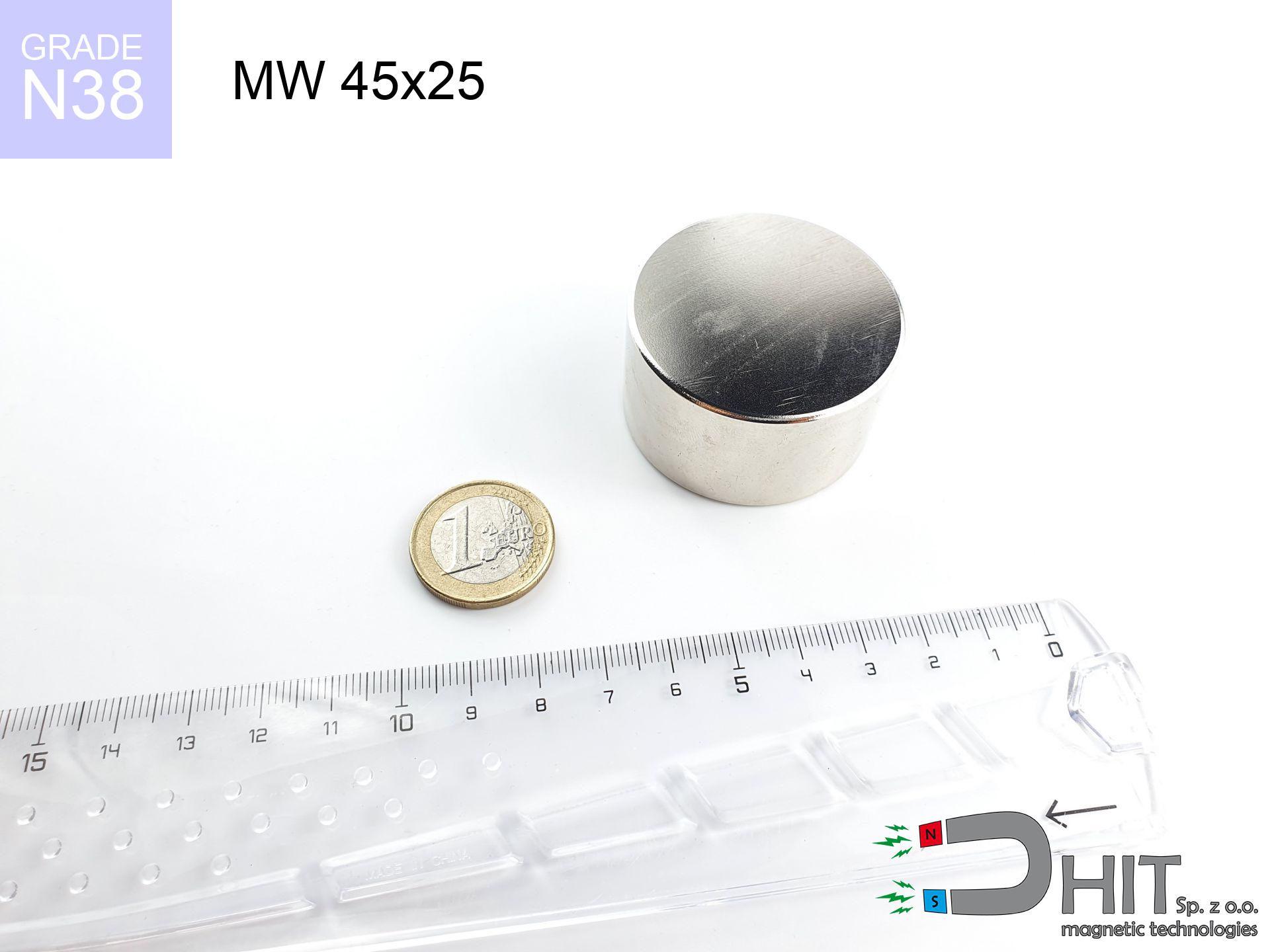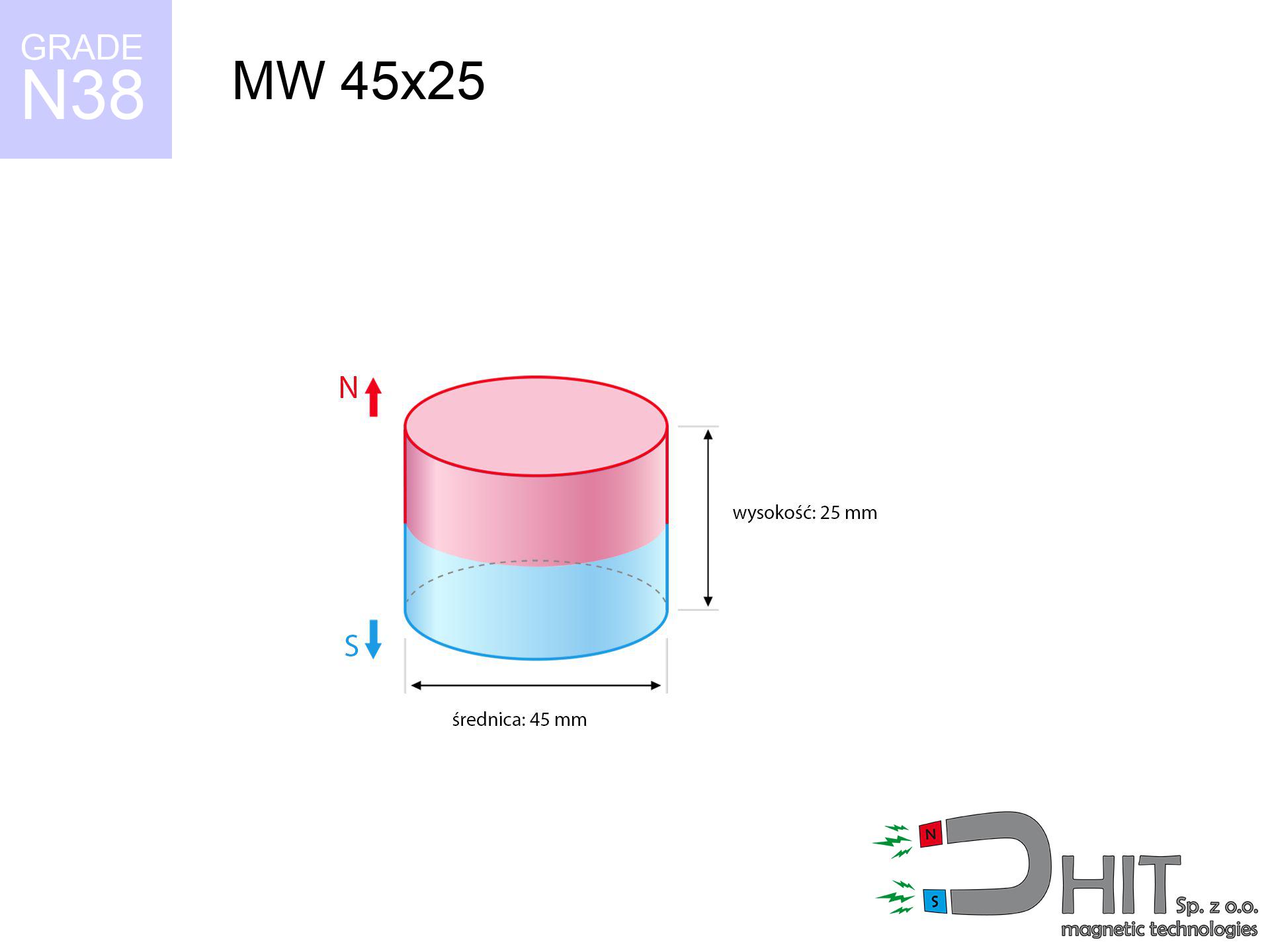MW 45x25 / N38 - cylindrical magnet
cylindrical magnet
Catalog no 010072
GTIN: 5906301810711
Diameter Ø [±0,1 mm]
45 mm
Height [±0,1 mm]
25 mm
Weight
298.21 g
Magnetization Direction
↑ axial
Load capacity
62.21 kg / 610.07 N
Magnetic Induction
460.72 mT
Coating
[NiCuNi] nickel
101.55 ZŁ with VAT / pcs + price for transport
82.56 ZŁ net + 23% VAT / pcs
bulk discounts:
Need more?Not sure which magnet to buy?
Call us now
+48 888 99 98 98
alternatively let us know via
contact form
the contact section.
Weight as well as appearance of a magnet can be checked with our
modular calculator.
Same-day processing for orders placed before 14:00.
MW 45x25 / N38 - cylindrical magnet
Magnetic properties of material N38
Physical properties of NdFeB
Shopping tips
Moreover, even though neodymium is part of the strongest magnets, they are susceptible to corrosion in humid environments. For this reason, they are coated with a coating of epoxy to protect them from corrosion. Interestingly that NdFeB neodymium magnets are about 13% lighter than SmCo magnets and, despite their power, easily break, which requires special caution during their handling. For this reason, any mechanical processing should be done before they are magnetized.
In terms of safety, there are several recommendations regarding the use of these magnets. They should not be used in acidic, basic, organic environments or in solvents, as well as in water or oil. Furthermore, they can distort data on magnetic cards and hard drives, although data deletion using a neodymium magnet is not always certain.
In terms of properties in different environments, neodymium magnets are sensitive to corrosion, especially in humid conditions. Therefore, they are often coated with coatings, such as epoxy, to preserve them from external factors and prolong their durability. Temperatures exceeding 130°C can result in a reduction of their magnetic properties, although there are specific types of neodymium magnets that can withstand temperatures up to 230°C.
As for risks, it is important to avoid using neodymium magnets in acidic conditions, basic environments, organic or solvent environments, unless they are properly protected. Additionally, their use is not recommended in water, oil, or in an atmosphere containing hydrogen, as they may lose their magnetic strength.
Advantages and disadvantages of neodymium magnets NdFeB.
Besides their magnetic performance, neodymium magnets are valued for these benefits:
- They retain their attractive force for nearly ten years – the loss is just ~1% (in theory),
- They remain magnetized despite exposure to strong external fields,
- By applying a shiny layer of silver, the element gains a sleek look,
- They possess intense magnetic force measurable at the magnet’s surface,
- They are suitable for high-temperature applications, operating effectively at 230°C+ due to advanced heat resistance and form-specific properties,
- The ability for custom shaping or adaptation to individual needs – neodymium magnets can be manufactured in a wide range of shapes and sizes, which amplifies their functionality across industries,
- Key role in new technology industries – they serve a purpose in hard drives, electric drives, diagnostic apparatus as well as high-tech tools,
- Compactness – despite their small size, they provide high effectiveness, making them ideal for precision applications
Disadvantages of NdFeB magnets:
- They can break when subjected to a heavy impact. If the magnets are exposed to physical collisions, they should be placed in a protective case. The steel housing, in the form of a holder, protects the magnet from cracks while also increases its overall resistance,
- Magnets lose magnetic efficiency when exposed to temperatures exceeding 80°C. In most cases, this leads to irreversible magnetic decay (influenced by the magnet’s dimensions). To address this, we provide [AH] models with superior thermal resistance, able to operate even at 230°C or more,
- Due to corrosion risk in humid conditions, it is recommended to use sealed magnets made of rubber for outdoor use,
- Limited ability to create internal holes in the magnet – the use of a housing is recommended,
- Potential hazard linked to microscopic shards may arise, if ingested accidentally, which is notable in the family environments. Additionally, small elements from these magnets have the potential to interfere with diagnostics after being swallowed,
- Higher purchase price is an important factor to consider compared to ceramic magnets, especially in budget-sensitive applications
Magnetic strength at its maximum – what it depends on?
The given holding capacity of the magnet corresponds to the highest holding force, assessed in ideal conditions, that is:
- using a steel plate with low carbon content, serving as a magnetic circuit closure
- having a thickness of no less than 10 millimeters
- with a smooth surface
- with zero air gap
- in a perpendicular direction of force
- under standard ambient temperature
Determinants of lifting force in real conditions
Practical lifting force is dependent on elements, listed from the most critical to the less significant:
- Air gap between the magnet and the plate, because even a very small distance (e.g. 0.5 mm) can cause a drop in lifting force of up to 50%.
- Direction of applied force, because the maximum lifting capacity is achieved under perpendicular application. The force required to slide the magnet along the plate is usually several times lower.
- Thickness of the plate, as a plate that is too thin causes part of the magnetic flux not to be used and to remain wasted in the air.
- Material of the plate, because higher carbon content lowers holding force, while higher iron content increases it. The best choice is steel with high magnetic permeability and high saturation induction.
- Surface of the plate, because the more smooth and polished it is, the better the contact and consequently the greater the magnetic saturation.
- Operating temperature, since all permanent magnets have a negative temperature coefficient. This means that at high temperatures they are weaker, while at sub-zero temperatures they become slightly stronger.
* Lifting capacity testing was performed on plates with a smooth surface of optimal thickness, under perpendicular forces, however under attempts to slide the magnet the holding force is lower. In addition, even a slight gap {between} the magnet and the plate decreases the load capacity.
Handle Neodymium Magnets Carefully
People with pacemakers are advised to avoid neodymium magnets.
Neodymium magnets generate strong magnetic fields. As a result, they interfere with the operation of a pacemaker. This is because many of these devices are equipped with a function that deactivates the device in a magnetic field.
Avoid bringing neodymium magnets close to a phone or GPS.
Magnetic fields interfere with compasses and magnetometers used in navigation for air and sea transport, as well as internal compasses of smartphones and GPS devices.
The magnet is coated with nickel - be careful if you have an allergy.
Studies show a small percentage of people have allergies to certain metals, including nickel. An allergic reaction often manifests as skin redness and rash. If you have a nickel allergy, you can try wearing gloves or simply avoid direct contact with nickel-plated neodymium magnets.
Do not give neodymium magnets to children.
Neodymium magnets are not toys. Be cautious and make sure no child plays with them. In the case of swallowing multiple magnets simultaneously, they can attract to each other through the intestinal walls. In the worst case scenario, this can lead to death.
Dust and powder from neodymium magnets are flammable.
Avoid drilling or mechanical processing of neodymium magnets. Once crushed into fine powder or dust, this material becomes highly flammable.
Keep neodymium magnets away from TV, wallet, and computer HDD.
Magnetic fields generated by neodymium magnets can damage magnetic storage media such as floppy disks, credit cards, magnetic ID cards, cassette tapes, video tapes, or other similar devices. They can also damage televisions, VCRs, computer monitors, and CRT displays. You should especially avoid placing neodymium magnets near electronic devices.
Neodymium magnets can become demagnetized at high temperatures.
While Neodymium magnets can lose their magnetic properties at high temperatures, it's important to note that the extent of this effect can vary based on factors such as the magnet's material, shape, and intended application.
Magnets will attract to each other, so remember not to allow them to pinch together without control or place your fingers in their path.
Neodymium magnets will bounce and clash together within a radius of several to around 10 cm from each other.
Magnets made of neodymium are extremely fragile, they easily fall apart as well as can crumble.
Magnets made of neodymium are fragile and will break if allowed to collide with each other, even from a distance of a few centimeters. Despite being made of metal and coated with a shiny nickel plating, they are not as hard as steel. At the moment of collision between the magnets, tiny sharp metal fragments can be propelled in various directions at high speed. Eye protection is recommended.
Neodymium magnets are the strongest magnets ever invented. Their power can surprise you.
Make sure to review all the information we have provided. This will help you avoid harm to your body and damage to the magnets.
Caution!
So that know how powerful neodymium magnets are and why they are so dangerous, read the article - Dangerous very strong neodymium magnets.




![UI 45x13x5 [M301] / N38 - badge holder UI 45x13x5 [M301] / N38 - badge holder](https://cdn3.dhit.pl/graphics/products/ui45x13x5-m301-vud.jpg)
![SM 25x300 [2xM8] / N42 - magnetic separator SM 25x300 [2xM8] / N42 - magnetic separator](https://cdn3.dhit.pl/graphics/products/sm-25x300-2xm8-kud.jpg)
![BM 550x180x70 [4x M8] - magnetic beam BM 550x180x70 [4x M8] - magnetic beam](https://cdn3.dhit.pl/graphics/products/bm-550x180x70-4x-m8-nic.jpg)


